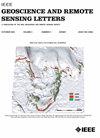Infrared and Visible Image Fusion Method by Using Hybrid Representation Learning
IF 4
3区 地球科学
Q2 ENGINEERING, ELECTRICAL & ELECTRONIC
引用次数: 11
Abstract
For remote sensing image fusion, infrared and visible images have very different brightness due to their disparate imaging mechanisms, the result of which is that nontarget regions in the infrared image often affect the fusion of details in the visible image. This letter proposes a novel infrared and visible image fusion method basing hybrid representation learning by combining dictionary-learning-based joint sparse representation (JSR) and nonnegative sparse representation (NNSR). In the proposed method, different fusion strategies are adopted, respectively, for the mean image, which represents the primary energy information, and for the deaveraged image, which contains important detail features. Since the deaveraged image contains a large amount of high-frequency details information of the source image, JSR is utilized to sparsely and accurately extract the common and innovation features of the deaveraged image, thus, accurately merging high-frequency details in the deaveraged image. Then, the mean image represents low-frequency and overview features of the source image, according to NNSR, mean image is classified well-directed to different feature regions and then fused, respectively. Such proposed method, on the one hand, can eliminate the impact on fusion result suffering from very different brightness causing by different imaging mechanism between infrared and visible image; on the other hand, it can improve the readability and accuracy of the result fusion image. Experimental result shows that, compared with the classical and state-of-the-art fusion methods, the proposed method not only can accurately integrate the infrared target but also has rich background details of the visible image, and the fusion effect is superior.基于混合表示学习的红外与可见光图像融合方法
在遥感图像融合中,由于红外图像与可见光图像的成像机制不同,其亮度差异很大,这导致红外图像中的非目标区域往往会影响可见光图像中细节的融合。本文将基于字典学习的联合稀疏表示(JSR)和非负稀疏表示(NNSR)相结合,提出了一种基于混合表示学习的红外和可见光图像融合方法。在该方法中,分别对代表主要能量信息的均值图像和包含重要细节特征的去平均图像采用不同的融合策略。由于去平均图像中含有大量源图像的高频细节信息,因此利用JSR稀疏准确地提取去平均图像的共同特征和创新特征,从而准确地合并去平均图像中的高频细节。然后,均值图像代表源图像的低频特征和概览特征,根据NNSR对均值图像进行分类,并分别针对不同的特征区域进行融合。该方法一方面消除了红外图像与可见光图像成像机制不同导致的亮度差异对融合结果的影响;另一方面,可以提高融合结果图像的可读性和准确性。实验结果表明,与经典和先进的融合方法相比,该方法不仅能够准确地融合红外目标,而且具有丰富的可见光图像背景细节,融合效果优越。
本文章由计算机程序翻译,如有差异,请以英文原文为准。
求助全文
约1分钟内获得全文
求助全文
来源期刊

IEEE Geoscience and Remote Sensing Letters
工程技术-地球化学与地球物理
CiteScore
7.60
自引率
12.50%
发文量
1113
审稿时长
3.4 months
期刊介绍:
IEEE Geoscience and Remote Sensing Letters (GRSL) is a monthly publication for short papers (maximum length 5 pages) addressing new ideas and formative concepts in remote sensing as well as important new and timely results and concepts. Papers should relate to the theory, concepts and techniques of science and engineering as applied to sensing the earth, oceans, atmosphere, and space, and the processing, interpretation, and dissemination of this information. The technical content of papers must be both new and significant. Experimental data must be complete and include sufficient description of experimental apparatus, methods, and relevant experimental conditions. GRSL encourages the incorporation of "extended objects" or "multimedia" such as animations to enhance the shorter papers.
 求助内容:
求助内容: 应助结果提醒方式:
应助结果提醒方式:


